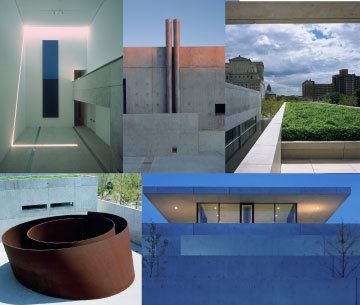
Starting my job as the public relations coordinator at the Pulitzer meant getting a crash course on how to answer all of our “Frequently Asked Questions”: when we opened, who’s the architect, our hours, exhibition dates, etc. I also got a crash course on what I’ll call the “Frequently Asked Misconceptions”:
Are all these works a part of the Pulitzer family collection? Don’t you need reservations to get inside? Why are you never open? Why don’t you have labels? Aren’t you a museum?
Not surprisingly, there are a LOT of questions. But all of these nuances (though sometimes challenging to communicate in, say, a succinct press release) makes this place what it is—a fascinating, evolving, experimental museum that’s not a museum.
The Pulitzer was originally intended to house large-scale sculptures in the Pulitzer collection. It quickly evolved into a space where exhibitions are chosen in relation to the architecture, instead of an art historical narration or presenting works from a specific collection. Works within the exhibitions are on loan from a variety of public and private collections. The visitor’s personal experience with the art is key; therefore there are no labels to detract from your immediate aesthetic experience with the work. We provide exhibition booklets at our front desk as an option for further information. Tadao Ando, the building’s architect, was recommended to the founder Emily Rauh Pulitzer and her late husband Joseph Pulitzer, via Richard Serra and Ellsworth Kelly. Two of the four works owned by the institution are commissioned works by these artists. We’re free to the public, and no reservations are necessary. We are only open on Wednesday and Saturdays, so we can remain flexible to explore other types of programming that would use the gallery spaces. I could go on and on (like I said, it’s hard to write succinctly), but hopefully through these posts, I’ll be able to give you an idea of what the institution is, where it seems to be heading, and get thoughts and feedback from all of you.
Our board chairman, Bill Bush, summed it up nicely in a recent interview for Boot Print (more to come on that publication too):
“Our development in this short period of time is very different from that of other art institutions: instead of following existing role models, we are defining ourselves institutionally as we go.”